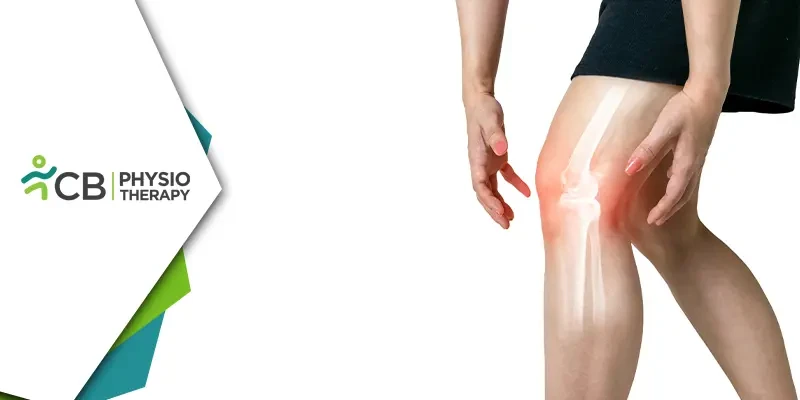The human knee is a marvel of engineering, allowing us to perform a wide range of activities from walking and running to sitting and standing. However, this intricate joint is also susceptible to various injuries and conditions, often leading to pain behind the knee. In this blog, we'll delve into the causes of knee pain and discuss the pivotal role that physiotherapy plays in relieving and preventing it.
Pain Behind the Knee
Pain behind the knee can be a result of multiple factors, each demanding a unique approach to treatment. Understanding the root cause of the pain is crucial for effective management.1: Muscle Strains and Tears: The muscles surrounding the knee, such as the hamstring or calf muscles, can be strained or torn due to overuse, poor conditioning, or sudden exertion. This can result in pain behind the knee, often accompanied by swelling and limited mobility.
2: Ligament Injuries: Injuries to the ligaments, particularly the posterior cruciate ligament (PCL) or medial collateral ligament (MCL), can lead to pain behind the knee. These injuries are often associated with sports-related incidents or trauma.
3: Bursitis: Bursae are small fluid-filled sacs that cushion and reduce friction between bones, tendons, and muscles. Inflammation of the bursa behind the knee can cause pain and swelling.
4: Tendonitis: The tendons connecting the muscles to the bones can become inflamed due to overuse or repetitive movements. This condition, known as tendonitis, can result in pain behind the knee, particularly if it affects the patellar tendon (patellar tendonitis).
5: Arthritis: Various forms of arthritis, including osteoarthritis and rheumatoid arthritis, can affect the knee joint, leading to chronic pain and stiffness behind the knee.
6: Meniscus Tears: The meniscus is a rubbery cartilage that acts as a cushion between the shinbone and thighbone. Tears in the meniscus can cause pain behind the knee, often accompanied by a clicking or locking sensation.
7: Popliteal Cysts: Also known as Baker's cysts, these fluid-filled sacs can develop behind the knee due to excess synovial fluid. When they enlarge or rupture, they can cause pain and swelling.
Role of Physiotherapy in Managing Knee Pain
Physiotherapy, also known as physical therapy, plays a pivotal role in managing and alleviating pain in the knee. It offers a non-invasive and holistic approach to address the root causes of knee pain, enhance mobility, and prevent further injuries. Here's how physiotherapy can make a significant difference:A physiotherapist begins the treatment process by conducting a thorough assessment of the patient's condition. This involves evaluating the patient's medical history, conducting physical examinations, and identifying the specific cause of the pain. Accurate diagnosis is essential for tailoring a treatment plan that suits the individual's needs.
1: Pain Management: Physiotherapists employ various pain relief techniques to alleviate discomfort. These may include modalities like TENS, ultrasound, electrical stimulation, and heat or cold therapy. Manual techniques, such as massage and joint mobilization, can also help relieve pain.
2: Strengthening and Conditioning: To address muscle imbalances and improve joint stability, physiotherapy programs often include exercises focused on strengthening the muscles around the knee. This helps in reducing the risk of future injuries and improving overall function.
3: Range of Motion Improvement: Physiotherapists work on restoring the normal range of motion in the knee joint. They use techniques like stretching, joint mobilization, and proprioceptive training to enhance flexibility and mobility.
4: Gait and Biomechanical Analysis: Gait analysis is a valuable tool in understanding how a person's walking or running mechanics may contribute to their knee pain. Physiotherapists can make adjustments to correct abnormal gait patterns and reduce stress on the knee joint.
5: Manual Therapy: Physiotherapists use hands-on techniques to release muscle tension, improve joint mobility, and correct alignment issues. This can be especially effective in addressing conditions like muscle strains, ligament injuries, and meniscus tears.
6: Bracing and Support: In some cases, the use of knee braces or supports may be recommended to provide stability and alleviate pain. A physiotherapist can help patients choose the appropriate brace and ensure it is worn correctly.
7: Patient-Specific Rehabilitation Programs: Every patient's needs are unique, and physiotherapists create individualized rehabilitation programs tailored to the patient's condition, goals, and lifestyle. This personalized approach is essential for effective treatment.
8: Post-Surgical Rehabilitation: Physiotherapy is crucial for post-operative recovery in cases where surgical intervention is required. Physiotherapists help patients regain strength and function while minimizing the risk of complications.
Pain behind the knee can be both distressing and debilitating, affecting one's ability to perform daily activities and enjoy an active lifestyle. Physiotherapy plays a central role in diagnosing, managing, and preventing knee pain by addressing the root causes and promoting healing through a combination of therapeutic modalities, exercises, and education.
If you're experiencing pain behind your knee, it's essential to consult a physiotherapist to receive a comprehensive evaluation and personalized treatment plan. With their expertise and guidance, you can look forward to reduced pain, improved mobility, and a better quality of life. Don't let knee pain hold you back – take the first step towards recovery and wellness with physiotherapy.

